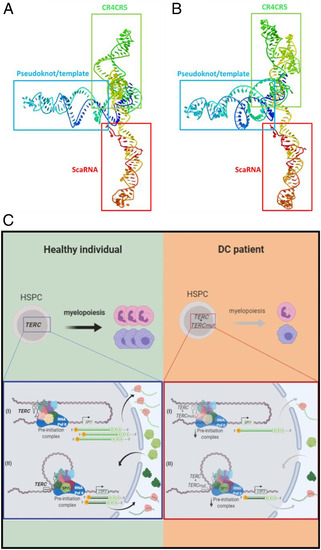Fig. 7
|
Predicting structure and proposed model of TERC function in myelopoiesis. (A and B) Prediction of TERC and TERC nG319A tertiary RNA structure. The processing of the structure was done with Jmol application of RNA Composer system (http://rnacomposer.cs.put.poznan.pl/), an open-source Java viewer for chemical structures in the third dimension (48). The different domains of the molecule are in different colors, starting 5′ in dark blue, followed by green, yellow, orange, and ending 3′ in red. (A) TERC wild-type structure. (B) TERC nG319A structure. (C) TERC regulation model of myeloid gene expression. Under normal conditions, TERC can regulate the expression of myelopoiesis genes (SPI1 and CSF3) in zebrafish and humans. Telomerase RNA binds DNA through its consensus binding sites and with RNA Pol II, facilitating its recruitment to myelopoietic gene promoters, ensuring robust myelopoiesis. DC patients with a mutation in the TERC CR4-CR5 domain, possibly due to a change in RNA structure, do not properly recruit RNA Pol II to promoters and fail to regulate the expression of myeloid genes, resulting in an alteration in myelopoiesis that causes a drop in myeloid cell production. This mechanism could serve as the basis for designing new strategies for therapeutic intervention. CR4-CR5 mutations will anticipate the development of myelodysplastic syndrome and signal the need for precision, personalized treatment. Pink cells are neutrophils and purple cells are macrophages; dark green proteins are G-CSF cytokine and light green protein are master transcriptional factor SPI1. |

